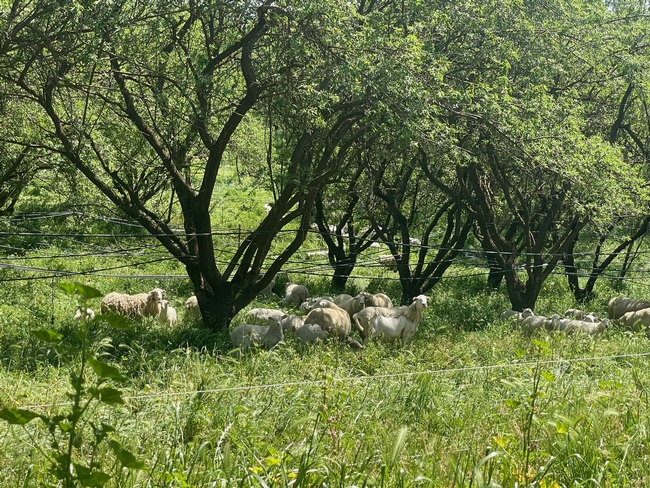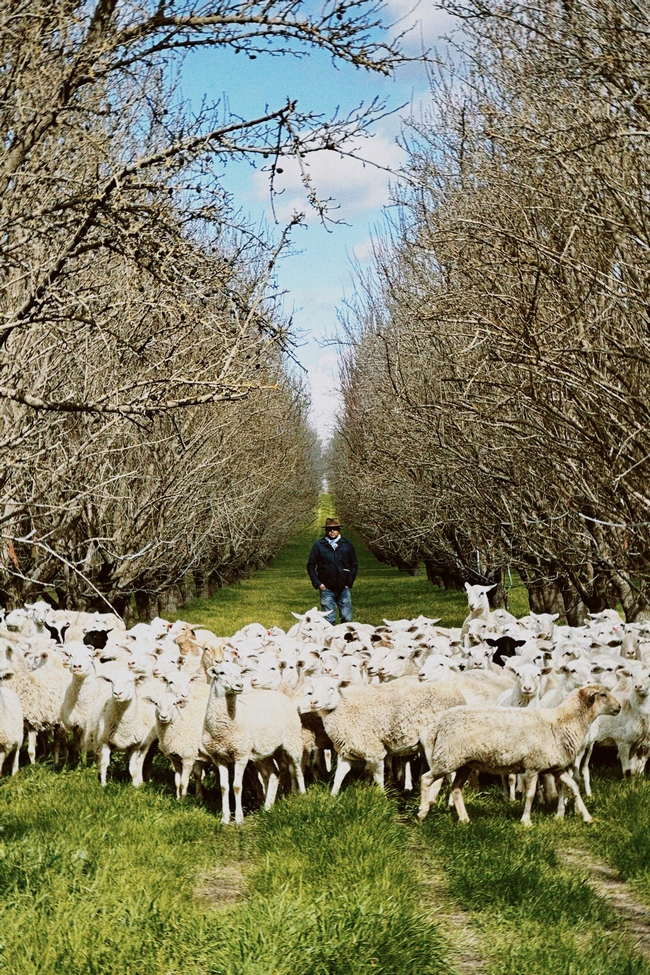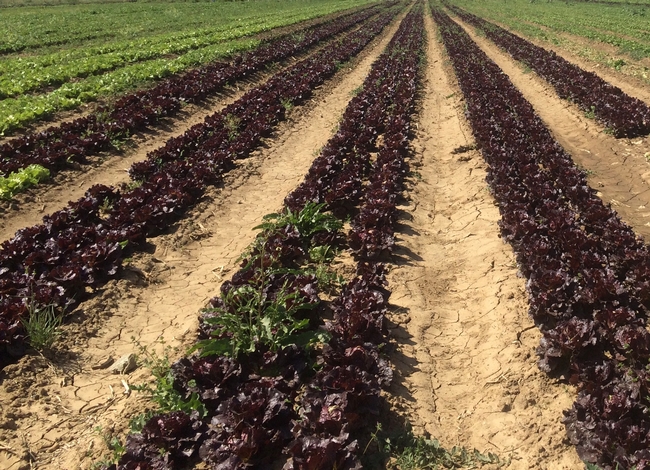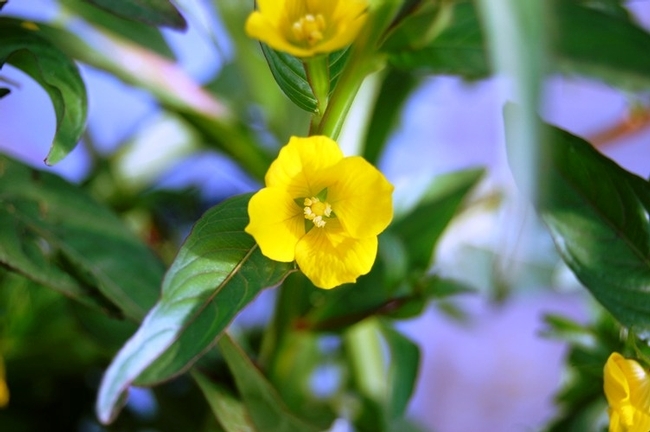Posts Tagged: orchards
USDA awards $2 million to study livestock grazing in organic orchards
UC, The Organic Center, University of Rhode Island partner on $3.5m food-safety study for organic produce growers
Grazing sheep and other livestock can help convert cover crops to fertilizer for orchard crops. To develop best management practices, the University of California and The Organic Center are collaborating on research to help organic orchard growers safely incorporate livestock grazing into their farming practices. The project is funded by a $2 million grant recently awarded through the U.S. Department of Agriculture's Organic Agriculture Research and Extension Initiative research program.
Interest in grazing livestock on cover crops in nut orchards has increased in recent years. However, research is needed to determine the best way to improve soil health and pest suppression, and to address concerns about food-borne pathogens and food safety.
“Organic farmers typically follow the USDA National Organic Program standards for raw animal manure, waiting 90 to 120 days between incorporating raw manure into the soil and harvesting the crop,” said Alda Pires, UC Cooperative Extension urban agriculture and food safety specialist in the School of Veterinary Medicine at UC Davis.
“Little research has been conducted to verify adequate waiting periods to reduce contamination risks in integrated crop-livestock production systems,” she said. “This research will fill the knowledge gap and facilitate the development of science-based food safety guidelines for grazing small ruminants in orchards.”
For this four-year project, “Influence of Orchard Grazing on Soil Health and Pest Control While Mitigating Food Safety Risk,” the scientists will study organic almond, walnut and pistachio orchards in two distinct nut-growing regions in California – the Sacramento Valley and San Joaquin Valley. The scientists will assess the effects of livestock grazing of cover crops on bacteria populations, soil health, pest control and economics.
Building soil health
“Growers have consistently raised the need for more information on grazing impacts on nutrient availability during tree growth, as well as potential to build up the biological, physical and chemical pillars of soil health,” said Amelie Gaudin, associate professor and endowed chair of agroecology in the UC Davis Department of Plant Sciences.
Livestock grazing may provide an opportunity to quickly enhance the amount of nitrogen that can be used by plants and microbes when the cover crop is terminated. “This project will help growers develop nitrogen budgets for these more diversified systems and quantify additional benefits and potential tradeoffs for soil health – such as compaction and salinity – to guide the development of place-based best management practices,” Gaudin said.
Pest management
Houston Wilson, UC Cooperative Extension specialist in the Department of Entomology at UC Riverside, will be studying the effects of livestock grazing on orchard pests.
“Navel orangeworm, or NOW, is by far the most destructive pest of almonds and pistachios,” Wilson said. “These moths overwinter in unharvested nuts in the orchard, and so removal and destruction of remnant nuts over the winter is the foundation of NOW control. While farmers typically use machinery to do this, grazing with animals may present a unique alternative that is more cost-effective and provides additional ecosystem benefits, such as soil health and weed control.”
Outreach to farmers
As part of the project, The Organic Center was awarded $75,000 to work with UC Agriculture and Natural Resources to direct national extension and education outreach activities. These will include a social media campaign, webinars and educational sessions and a technical report for growers.
“There is an increasing interest from organic farmers to learn how to incorporate livestock into their operations to gain better soil health and fertility,” said Amber Sciligo, director of science programs at The Organic Center.
“This research is very exciting because it will holistically explore the potential risks and benefits of livestock not just to soil health, but also pest control – a truly interdisciplinary project that matches the whole system of the organic farm.”
Produce food-safety management tools
For another organic food-safety project, Pires and Sciligo will be working with Patrick Baur, professor of Sustainable Agriculture and Food Systems at the University of Rhode Island.
The University of Rhode Island and The Organic Center received $3.5 million from USDA's Organic Agriculture Research and Extension Initiative research program for the new organic food-safety education project.
“We're going to develop a new food safety management tool designed specifically for organic soil amendments,” said Baur, who is leading the project. “We're also going to develop a suite of new communication and training tools aimed at the entire fruit and vegetable sector to build a shared language between organic agriculture and the food safety community and help them work better together.”
As part of the produce project, Pires of UC Davis was awarded $1.16 million to conduct a risk assessment and create a publicly accessible dashboard to meet the specific needs of organic growers operating at different scales, under different cropping systems, in different regions.
Also participating in this project will be Beatriz Martinez Lopez, professor in the School of Veterinary Medicine at UC Davis, and Abhinav Mishra and Govindaraj Dev Kumar of the University of Georgia.
Birds are beneficial too!
Across the globe, scientists have shown that birds can be farmer allies. Insectivorous birds feed on damaging insect pests in many crops including coffee, cacao, oil palm, corn, cabbage and apples. Raptors, including hawks and barn owls, feed on rodents, including gophers, voles and mice (see blog, Barn owls help clean up rodents naturally).
Despite this deep historic knowledge that birds are important predators of crop pests, over time the perception of birds as natural enemies of pests has been generally replaced with the idea that birds are often major crop pests themselves. Indeed, some bird species — like some types of insects — can cause trouble for farmers, but many others — especially those that eat insects and rodents — can be beneficial.
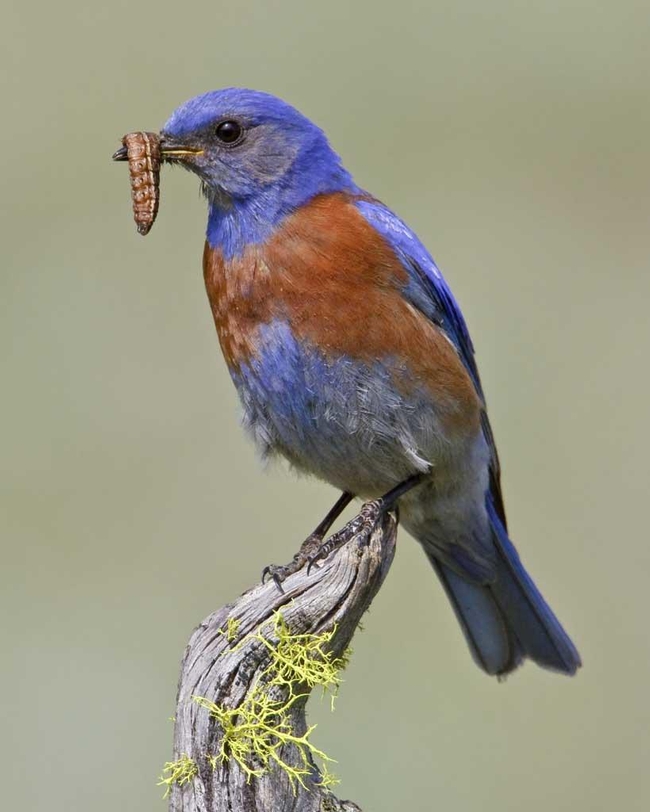
Do birds control insect pests on farms in California's Central Valley?
They do! Recent studies by Dr. Sacha Heath, UC Davis, and Rachael Long, field crops and pest management advisor, UC Cooperative Extension, showed that birds help control insect pests in walnut orchards. Dr. Sara Kross (UC Davis postdoctoral alumnus, now with Columbia University) showed that birds help control alfalfa insect pests.
Birds are voracious predators of codling moth pests in walnuts
Codling moth is a major worm-like pest that infests walnuts, apples and pears. The larvae go dormant during winter, living in cocoons in crevices in trees. Adult moths emerge in the spring, lay eggs and infest crops.
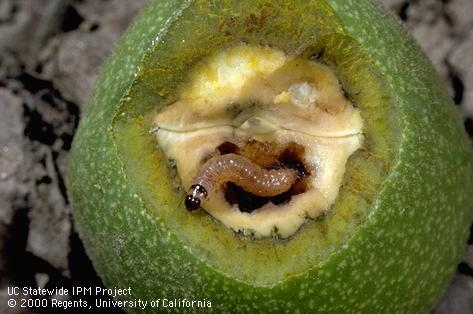
We evaluated bird predation of codling moth using “sentinel prey” and exclosure cages. We glued codling moth cocoons to walnut trunks and covered them with cages, allowing insects and spiders to access the cocoons, but not bird predators. This allowed us to count how many larvae were eaten inside and outside of the cages to estimate pest reduction by birds.
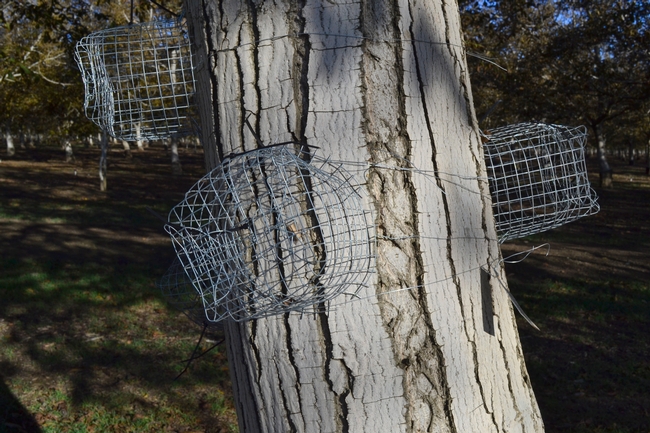
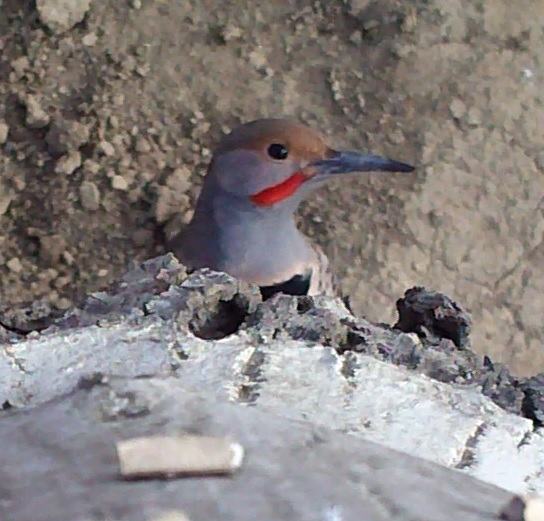
What did we find?
Natural enemies, like parasitic wasps and lacewings, alone reduced codling moth larval numbers by 11%; adding birds into the pest control system reduced them by 46%! Nuttall's woodpeckers and white-breasted nuthatches did a lot of the work; these birds travel up and down the trunks of trees, searching for insects.
Above, a white-breasted nuthatch preys on a codling moth larva “sentinel cocoon” on a walnut tree. Video by Sacha Heath.
Alfalfa weevils are no match for insectivorous birds
Alfalfa weevils are key pests of alfalfa, reducing yields and hay quality if left uncontrolled. Dr. Sara Kross looked at bird predation of this pest by excluding birds from alfalfa plants via cages, and counting the number of weevils inside and outside the cages. She found that birds reduced the number of weevils by more than 30%, showing their importance in helping to protect alfalfa from this serious pest.
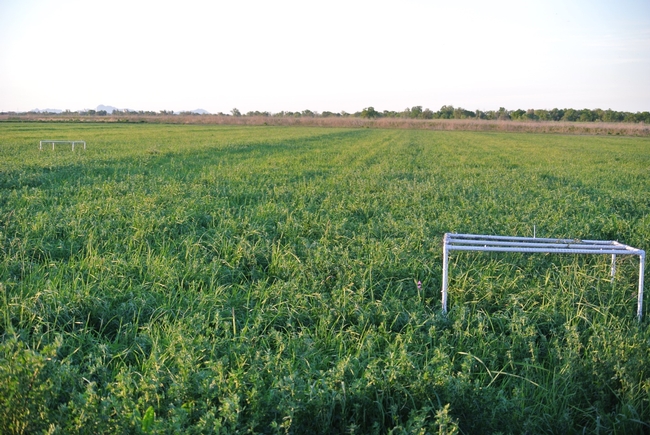
Does field edge habitat, like hedgerows, help attract beneficial birds?
Yes! Hedgerows are important habitat for beneficial birds, serving as nesting, foraging and roosting sites. In a study in the Sacramento Valley, crop margins with hedgerows, tree lines and riparian buffers harbored up to six times more birds and up to three times more bird species than bare or weedy margins.
Walnut orchards adjacent to hedgerows and riparian areas had higher numbers of beneficial birds along with more species. In alfalfa, there were more beneficial birds in fields when at least two tall trees were present along the field edges. More beneficial birds were associated with better pest control, that is, fewer codling moth cocoons and alfalfa weevils.
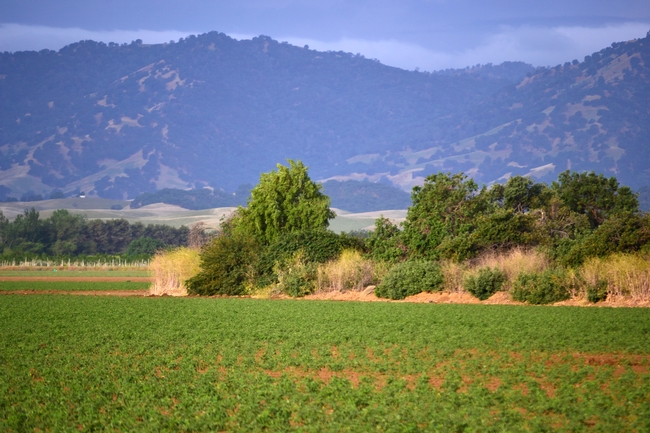
Birds have large territories, fly long distances, and are influenced by what happens on the farm as well as by what happens in the landscape around the farm. For example, we found that codling moth predation by birds greatly increased in walnut orchards as the amount of habitat in the landscape around the orchards increased (including hedgerows, tree lines, riparian and oak woodlands, and grasslands).
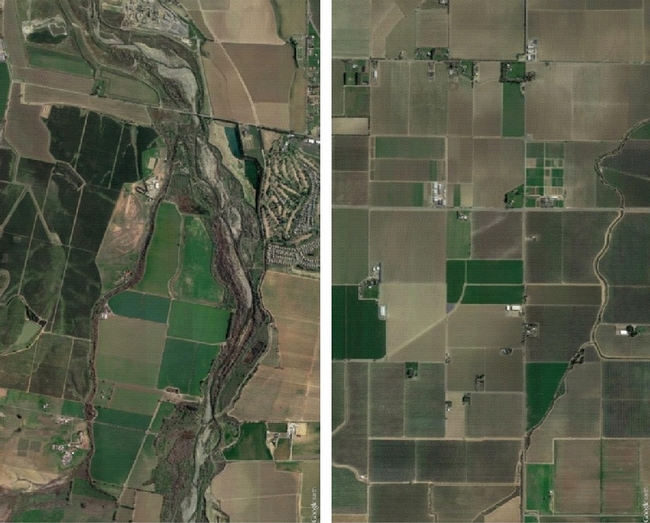
Will hedgerows increase the numbers of pest birds?
Pest birds are present on farms regardless of field edge habitat (such as weedy vegetation or hedgerows). Cases will be different, depending on the crop, but in the fields and orchards of Yolo County, researcher Hillary White (formerly with UCCE and now with U.S. Fish and Wildlife) found that three of the most common avian crop pests (American crow, red-winged blackbird and Brewer's blackbird), were up to 10 times more abundant in agricultural fields with bare or weedy margins than in fields with hedgerows.
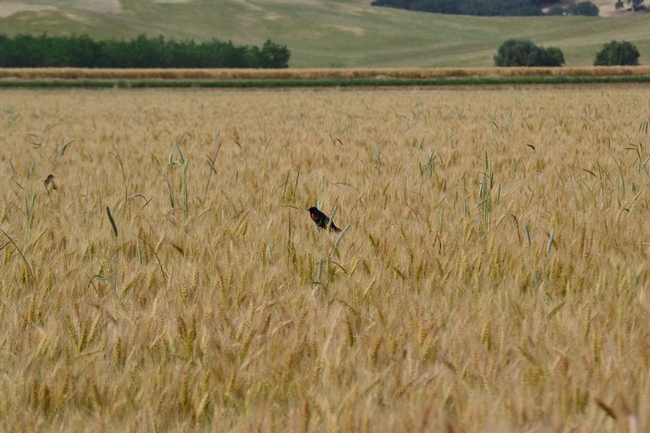
What can I do to attract beneficial birds to my farm?
Our avian research team has been quantifying the conditions under which birds are helpful or harmful to growers. We are looking for ways to help farmers create bird habitat on their farms to harness the beneficial pest control services birds can provide, while also protecting crops from the damaging effects of some bird species. This information is available in the new publication “Supporting Beneficial Birds and Managing Pest Birds,” co-authored by the Wild Farm Alliance and Drs. Kross and Heath, and technically advised by UC Cooperative Extension and several farmers. This is a user-friendly guide for farmers and conservation practitioners, with the goal of co-managing farmlands for biodiversity and farming.
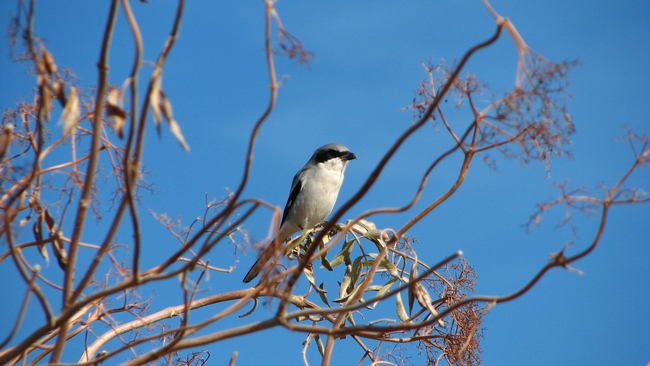
Dr. Sacha Heath received her PhD from UC Davis's Graduate Group in Ecology and will soon be starting a postdoctoral fellowship with the Living Earth Collaborative in St. Louis, Missouri.
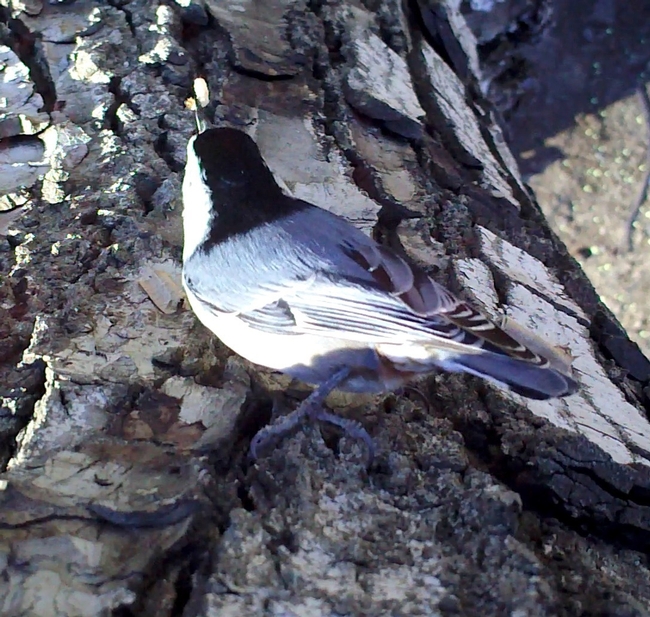
A white-breasted nuthatch preys on a codling moth larva “sentinel cocoon” on a walnut tree. (Video still: Sacha Heath)
Entomologists profiled in LA Times
Reporter Amina Khan with the LA Times profiled husband-and-wife entomologist team Christina and Mark Hoddle of UC Riverside (Mark is also a UC Cooperative Extension entomology specialist). The pair travel the world seeking parasitoids that can serve as biological control to invasive California pests and then test the results at the Center for Invasive Species Research at UC Riverside. "Bugs don't take weekends," Christina Hoddle told the reporter, "so neither do we."
Weed threatens rice-growing areas
Heather Hacking, Chico Enterprise Record
Photos and more details about the weed are also available from Luis Espino on the UC Rice Blog.
Autumn is for Apples: An Interview With Carol Fall
Jennifer Jewell, aNewsCafe.com
As apple season approaches, this article examines the Trinity Heritage Orchard Project through an interview of Carol Fall, program representative for UC Cooperative Extension Trinity County. The project has identified and mapped century-old apple trees from Gold Rush-era homesteads that are now on public lands and available for gleaning. Fall also evaluates how fruits of these heirloom varieties are best picked and used—whether for baking, cider-making, eating fresh or storing for winter months—and takes cuttings from the most significant varieties to plant elsewhere in the community. The article says Fall will provide apple samples Oct. 8 at Weaverville's annual Salmon Festival.

